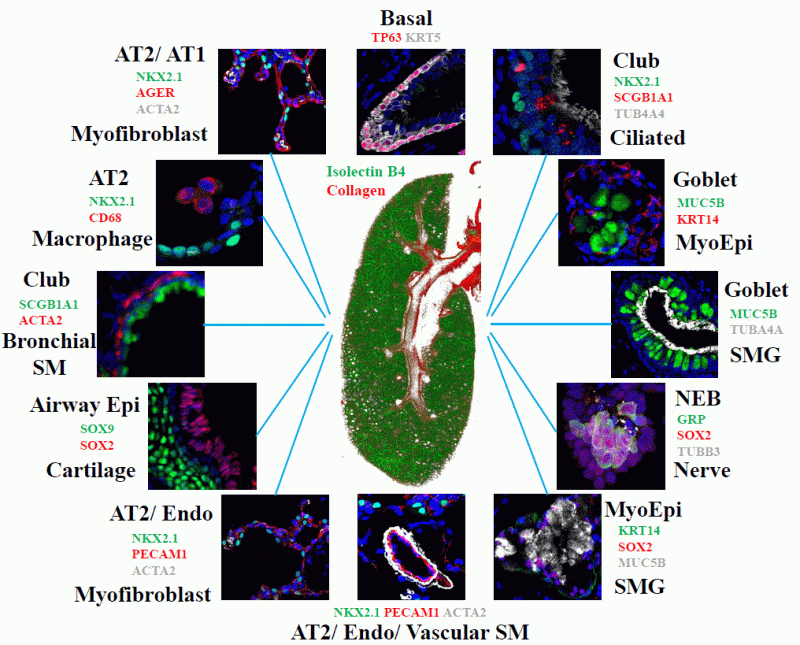This series is drawn from the publication “Building and Regenerating the Lung Cell by Cell” which compiles formative information derived from LungMAP experiments conducted by the LungMAP consortium, including researchers at Cincinnati Children’s Hospital Medical Center led by Dr. Jeffrey Whitsett.
The unique architecture of the mammalian lung allows us to breathe oxygen. Understanding cellular and molecular mechanisms of lung development provides insight into understanding the pathogenesis of acute and chronic lung diseases. Historically, morphological and ultrastructural studies were used to estimate the diversity of cell types forming the lung; however, development of single-cell RNA sequencing methods and advances in imaging technology enable new insights into the diversity of cell types, lineage relationships, cell-cell interactions, and gene expression accompanying embryogenesis, organogenesis, and disease pathogenesis. In this series of theme pages we will explore how recent single cell RNA sequencing data and high-resolution imaging have identified a vast heterogeneity of pulmonary cell types and cell selective gene expression underlying lung development. Further, advances in proteomics, while not yet at single cell level, complement RNA studies to provide insights into both transcriptional and post-transcriptional control of lung formation during embryogenesis, the perinatal period of respiratory adaptation, as well as during lung regeneration in response to disease or injury.
The ability to breathe air depends upon the efficient transfer of oxygen and carbon dioxide necessary for oxidative metabolism. The pathway for this transfer (respiratory tract) consists of semi-rigid conducting airway tubes that bifurcate, branch, and taper from the trachea, bronchi and bronchioles and lead to highly vascularized saccules called alveoli where respiratory gases are exchanged. These respiratory tubes consist of multiple cell types derived from embryonic components (neuroectoderm, mesoderm, and endoderm) as they evolve, a process called morphogenesis.
At center above is the right lobe of a mouse lung 3 days after birth (P03), an early stage for alveolar formation in the mouse. Green indicates the dense endothelial cells that line the pulmonary vasculature. Surrounding the lobe, diverse cell types (black font) that comprise the structure of the lung are identified by fluorescence antibody staining where colors (red, green and silver in images) correspond to known protein markers for specific cells.
A variety of epithelial cell types (cells that cover surfaces) line the respiratory tubes, each in precise numbers and positions to create the architectural features upon which ventilation depends. Skeletal muscles of the diaphragm and chest walls create a mechanical bellows that inflates and deflates the alveoli during each ventilatory cycle. The types of epithelial cells in the airways differ by location---those closer to the beginning of the pathway (proximal) are not the same cell types that reside deeper in the alveolar region where air exchange occurs (distal). The surface of the alveolar region is covered primarily by alveolar Type 1 (AT1) epithelial cells, which are in close contact to capillary endothelial cells (cells that line the interior surface of blood vessels and lymphatic vessels) where gas exchange occurs. An extensive lymphatic system controls pulmonary fluid balance -- precise control of capillary blood flow and alveolar-capillary permeability are necessary for proper gas exchange. The hydrated alveolar surfaces are in direct contact with inhaled gases creating surface tension and collapsing forces. These forces are minimized by the production of pulmonary surfactant lipids and proteins by alveolar type 2 epithelial cells (AT2 cells) that protect alveoli from collapse during the ventilatory cycle.
The complex lung structure is protected from continuous exposure to particles, pathogens and toxicants by a process called mucociliary clearance, the self-clearing mechanism of the bronchi. Mucociliary clearance depends upon precise regulation of surface fluids and electrolytes, and mechanical activity of ciliated and secretory cells to clear pathogens and particles. The lung is innervated, responding to central and peripheral inputs that influence cough, fluid secretion, and integrate neural control of oxygen, carbon dioxide, and pH sensing. Cells of the blood and immune systems are also abundant, including erythrocytes that transport oxygen, and diverse immune cells that are found both within the alveoli and lung parenchyma that constitute the innate and acquired immune system protecting the lung.
These many cells work together to orchestrate breathing. In the next pages, we look at how the lung develops at key age points in the mouse and human, detailing cell differentiation by molecular cues.



